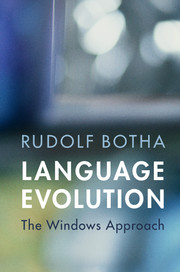
-
Select format
-
- Publisher:
- Cambridge University Press
- Publication date:
- March 2016
- March 2016
- ISBN:
- 9781316471449
- 9781107135130
- 9781316501078
- Dimensions:
- (228 x 152 mm)
- Weight & Pages:
- 0.59kg, 230 Pages
- Dimensions:
- (228 x 152 mm)
- Weight & Pages:
- 0.48kg, 230 Pages
- Subjects:
- Evolution of Language, Psychology, Cognition, Language and Linguistics
You may already have access via personal or institutional login- Subjects:
- Evolution of Language, Psychology, Cognition, Language and Linguistics
Book description
How can we unravel the evolution of language, given that there is no direct evidence about it? Rudolf Botha addresses this intriguing question in his fascinating new book. Inferences can be drawn about language evolution from a range of other phenomena, serving as windows into this prehistoric process. These include shell-beads, fossil skulls and ancestral brains, modern pidgin and creole languages, homesign systems and emergent sign languages, modern motherese, language use of modern hunter-gatherers, first language acquisition, similarities between language and music, and comparative animal behaviour. The first systematic analysis of the Windows Approach, it will be of interest to students and researchers in many disciplines, including anthropology, archaeology, linguistics, palaeontology and primatology, as well as anyone interested in how language evolved.
Reviews
‘In 2006, Rudie Botha launched an all out attack on the legitimacy of the claim that the South African archaeological site of Blombos had evidence of 'fully syntactic' language 75,000 years ago. No one has been able to counter the logic of his argument, and this book applies that same relentless, illuminating logic to other claims in the study of language origins. In doing so, Botha shows just how carefully any claims must be justified, and just how powerful his Windows Approach is. Students and researchers in archaeology, primatology, linguistics, and comparative ethology cannot ignore this book.'
Iain Davidson - University of New England
'This book will prove to be a milestone in the field … a meticulous, rigorous, and yet highly readable guide.'
Paul T. Roberge - University of North Carolina, Chapel Hill
Contents
Metrics
Altmetric attention score
Full text views
Full text views help Loading metrics...
Loading metrics...
* Views captured on Cambridge Core between #date#. This data will be updated every 24 hours.
Usage data cannot currently be displayed.
Accessibility standard: Unknown
Why this information is here
This section outlines the accessibility features of this content - including support for screen readers, full keyboard navigation and high-contrast display options. This may not be relevant for you.
Accessibility Information
Accessibility compliance for the PDF of this book is currently unknown and may be updated in the future.


